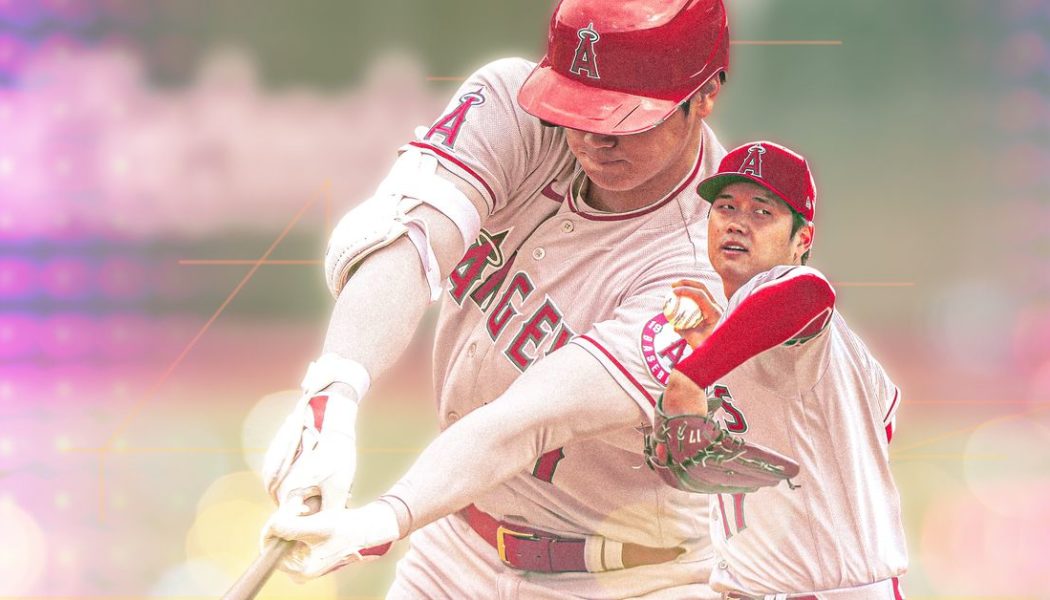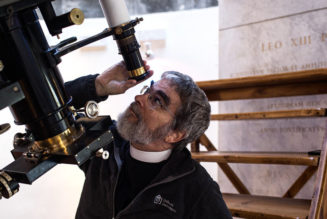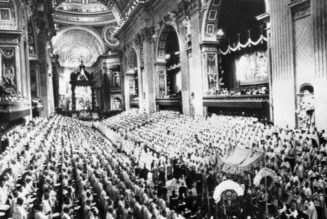
Even amid mounting concerns about 1968-throwback batting averages, surging strikeout rates, and rampant injuries, MLB’s leaderboards are lousy with standout stats, skills, and story lines: The power and plate discipline of Ronald Acuña Jr. and Vladimir Guerrero Jr. The slugging and speed of Fernando Tatis Jr., Mike Trout, and Byron Buxton, whose only vulnerabilities are swings and strides so explosive that sometimes their own bodies betray them. The unexpected tears of 28-year-old rookies Adolis García and Yermín Mercedes. The unquestioned acehood of Jacob deGrom and Gerrit Cole. The no-hit heroics of Joe Musgrove, Carlos Rodón, and John Means. The brilliance of the Brewers’ Big Three (Corbin Burnes, Brandon Woodruff, and Freddy Peralta).
Yet visitors to FanGraphs, baseball’s sabermetric site of record, have sought out one star above all others this season: Shohei Ohtani. Dating back to Opening Day, the two-way wonder’s FanGraphs hitter page has been a bigger attraction by far than the page of any other player. Add the traffic from Ohtani’s pitcher page to the total from his hitter page, and the 26-year-old Angel has outdrawn any two other superstars combined—or any three not counting Trout, the distant-second-place player, who’s garnered hardly half the views of Ohtani. Ohtani also has the most-viewed player page at MLB.com, leading runner-up Trout by almost 60 percent. (At the more historically oriented Baseball-Reference, where active players who rank high on all-time leaderboards rack up extra clicks, Ohtani trails only former teammate Albert Pujols.)
Robust traffic at stat sites is one way to measure Ohtani’s appeal, but Ohtani mania manifests itself everywhere one looks: in the GIFs and videos that circulate on social media after every nasty splitter, screaming batted ball, or giddy grin; in the frequent tributes from awed direct competitors and superstars of other sports; in the way his name almost always appears after Angels scores on broadcasts’ bottom lines, even if he went 0-for-4. Nearly a third of the way through the regular season, Ohtani is flourishing in a fashion that seemed inconceivable until he showed it could be done. After a few years of flashing his tantalizing tools between injuries that prevented him from pitching and diminished his hitting, Ohtani has harnessed his powers on both sides of the ball. By combining the best of his bat, his arm, and his legs with his most elusive skill, health, he’s become the best show in baseball, and perhaps in all of sports.
[embedded content]
Ohtani boasts a 154 wRC+ and a 163 ERA+, which means that per those metrics, he’s been more than 50 percent better than average on both sides of the ball. As a hitter, he’s slugged .597 with 15 homers and seven stolen bases in 206 plate appearances, and as a pitcher, he’s produced a 2.72 ERA with 50 strikeouts in 36 1/3 innings. In 2016, the 21-year-old Ohtani was the best pitcher and second-best hitter in Japan’s highest-level league. The 26-year-old Ohtani hasn’t dominated to the same degree in MLB, but by some measures, he’s been both a top-15 hitter and a top-15 pitcher on a rate basis: He ranks 11th in wRC+ among qualified hitters, and 12th among pitchers with at least 30 innings pitched in park-adjusted deserved run average.
Ohtani’s total production puts him toward the top of the heap in overall value, despite a light pitching workload and the steep positional penalty WAR applies to DHs. Ohtani is seventh in the majors (and third in the American League) in Baseball-Reference WAR, and 17th in the majors (and eighth in the AL) in FanGraphs WAR. He’s a credible MVP candidate based on stats alone, before factoring in the high degree of difficulty of his dual roles, the excitement he generates by breaking the mold, and any extra value that the Angels accrue from squeezing a hitter, a pitcher, and an occasional outfielder into a single roster spot. He’s also leading all hitters in win probability added, reflecting the fact that many of his hits have come at opportune times.
Ohtani’s raw abilities were never in doubt, but none of his recent success was assured. Even after 2018, when he answered any questions about whether his NPB approach would translate to the States, uncertainty surrounded his capacity to stand up to the strain of two-way play. Last November, a demoralized Ohtani described feeling “frustrated” and “useless” after a “pathetic” 2020, in which a flexor strain in his surgically repaired elbow mostly kept him off the mound, and lingering soreness in his surgically repaired knee sapped his power. Fully healthy this spring for the first time in years, and bolstered by ample work in the weight room and offseason study at Driveline, Ohtani entered 2021 ready to remove the restrictions that limited his playing time in 2018 (even when he wasn’t hurt). In spring training, he rekindled dreams about best-case scenarios by batting .548/.571/1.032 with five homers in 31 at-bats and touching triple digits while striking out 17 hitters in 10 1/3 innings. Since the regular season started, the unleashed Ohtani hasn’t done much to dampen the renewed enthusiasm.
[embedded content]
Ohtani is tied with Acuña for the major league lead in barrels—the highest-value type of hard-hit batted ball—but thanks to his speed, he also leads all hitters with at least 100 plate appearances in infield hit rate, or the percentage of ground balls that turn into hits. Twice this season, he’s bunted for a hit and crushed a ball more than 110 mph in the same game. Ohtani’s 119 mph double on April 12 made him one of only five hitters since Statcast coverage began in 2015 to launch a ball that hard, along with Nelson Cruz and the Yankees trio of Giancarlo Stanton, Aaron Judge, and Gary Sánchez. Angel Stadium inflates left-handed home-run totals more than any other park, but Ohtani’s dingers aren’t cheapies. He leads all hitters in expected home runs, per MLB’s Statcast system, which estimates that he would have gone deep just as often in a composite of other parks. Ohtani’s offseason strength training is evident in how often he drives pitcher’s pitches: No hitter has done more damage on deliveries in the “shadow zone,” the region around the edges of the strike zone.
No other sport offers as many metrics as baseball in the age of pitch-tracking technology, and no player stuffs the stat sheets like Ohtani. As MLB.com’s Andrew Simon noted, Ohtani is one of five qualifiers (along with Acuña, Trout, Tatis, and Tyler O’Neill) to place in the 90th percentile or higher in both barrel rate and sprint speed. (All five actually rate in the 95th percentile and above in both categories.) But Ohtani also rates in the 89th percentile or higher in expected batting average, expected slugging percentage, whiff rate, and barrel rate as a pitcher. Only five hitters have put as much of a hurting on heaters as Ohtani, and only two have done better at punishing four-seamers, specifically. Not only can Ohtani take on high-speed pitches, he can dish them out: Among starting pitchers, only deGrom has exceeded Ohtani’s 101.1 mph max speed. But Ohtani’s highest-speed offerings serve to set up his splitter, the game’s most valuable weapon on a per-pitch basis. No other pitch has a higher putaway percentage, or rate of two-strike deliveries that result in a strikeout.
Walks have been Ohtani’s one weakness on the mound. Among pitchers who’ve thrown at least 30 innings, only Cleveland’s Triston McKenzie has issued free passes at a higher rate. That wildness may be a by-product of Ohtani’s surgery, long layoff, and low innings totals over the past several seasons. Before he got hurt in 2018, he’d walked 3.6 batters per nine innings, which was in line with his 3.4 per nine career rate in Japan. If his control could return to that level, compared to his current rate of 6.4 per nine, he could go deeper in games and offset some regression in batted-ball luck.
In four of his seven starts as a pitcher, Ohtani has also batted in his customary second spot in the lineup, as the Angels surrendered the DH—something no AL team had done on purpose since 1976—to keep one of their best bats in the lineup. His unique usage yields a litany of “first since” fun facts, most of which still exclude the Negro Leagues: He’s the first player since 1952 to strike out 10 or more batters and then play a non-pitcher position; the first starting pitcher to bat second since 1903; the first player to lead off the day after making a start as a pitcher; and the first player since Babe Ruth in 1921 to start on the mound while leading the league in home runs.
[embedded content]
Ohtani regularly (but never routinely) performs feats that haven’t been seen since the first few decades of the 20th century, when Ruth and a quartet of two-way Negro Leagues legends—Bullet Rogan, Martín Dihigo, Double Duty Radcliffe, and Leon Day—hit and pitched against talent diluted by the color barrier. Ohtani’s résumé makes him sound like some sepia-toned figure out of Ken Burns’s Baseball, or a maxed-out custom player in MLB The Show, or a Sidd Finch–style hoax. But he’s real, spectacular, and doing what he’s doing in modern-day high-def, against history’s highest-caliber competition, in a year when pitcher-hitters have slashed .108/.145/.140 with a 46.5 percent strikeout rate that will soon consign them to the scrap heap.
Not since the 1998 home run race has a player made it so essential to check the box scores every day. And not since Bo Jackson (a different type of two-way player) was snapping bats and climbing outfield walls has a baseball player’s athleticism loomed so large over the sports landscape. Ohtani has already earned the admiration of non-baseball athletic luminaries like J.J. Watt and Kevin Durant, and the praise he’s received from opposing players is even more effusive. Last month, Boston’s Matt Barnes echoed CC Sabathia by calling Ohtani “the most physically gifted baseball player I’ve ever seen”—immediately after Ohtani took him deep for a game-winning homer. Barnes’s words were restrained compared to those of Marcus Stroman, who dubbed Ohtani “a mythical legend in human form.”
Ohtani is a mythical legend in human form. What he’s doing is beyond incredible. Everyone in the big leagues is in awe of his talent. After games, I be running to my phone to check and see what Ohtani did on the night! Lol
— Marcus Stroman (@STR0) May 19, 2021
In recent seasons, we’ve seen Trout compile WAR at an unprecedented pace, deGrom and other pitchers raise the ceiling for stuff, and a generation of precocious players reset statistical expectations and overturn unwritten rules. But no player has broken baseball the way Ohtani has: He’s like Tiger, Serena, or Steph, someone whose game is so extraordinary that even non-aficionados can watch it in wonder. He’s also easy to root for, an expressive but apparently imperturbable player who gets fired up after big pitches but who answers on-field affronts with steals and strikeouts instead of angry words and brushback pitches. Only the regional nature of baseball fandom, cultural conventions, and the language barrier—plus the Angels’ persistent suckitude—are preventing Ohtani from becoming the face of the sport, an international icon, and the star of a spinoff of Space Jam. Have we mentioned that he’s swole and models on the side?
[embedded content]
Ohtani’s superhuman highlights are the hook of his story, but part of his allure stems from the thrill of the unknown. Baseball history is so extensive that players rarely enter uncharted terrain. Yet the Angels and Ohtani are laying down track right in front of the train, feeling out together what workload he can tolerate and how he can be used. Now that he’s pitched and hit in the same game and played the outfield four times, what will his next act be? Might he start in the outfield in an NL park? Might he move to the mound in a save situation? Would you want to bet against him?
[embedded content]
Preceding superlatives notwithstanding, Ohtani’s most impressive stat this season is his games played total, 53, another number that places him among the league leaders. He’s missed only one Angels contest this season, sitting out the first game of a late-May doubleheader the day after he pitched. As MLB’s injury rate reaches a new high and prominent players across the sport find themselves sidelined for large swaths of the season, Ohtani, the multi-time surgery survivor and the player whose assignment arguably makes him most susceptible to injury, has found durability. It’s headline-worthy when he doesn’t start.
What makes Ohtani’s breakout campaign so compelling is the inescapable suspicion that he’s too good to be true. Despite his superpowers, he’s no more impervious to pain than anyone else. Even this season, he’s had his close calls: In April, he endured blister issues and pitch-count limits and emerged mostly unscathed from a scary collision at home plate. In early May, he was scratched from a start (as a pitcher, but not as a DH) after being plunked by a pitch, and a mid-May outing was postponed due to tiredness. He returned to the mound on May 19, but he suffered a significant velocity dip, prompting flashbacks to 2018. Most of his missing speed resurfaced in his next start, but the blip left fans shaken. As his command comes and goes and he fends off fatigue (and Bay Area traffic), his high-wire act generates nonstop suspense. He’s a protagonist without plot armor, a cartoon character who at any time could look down and discover that he’s already run off the cliff. Every episode of the Ohtani show has the potential to be a cathartic triumph or an unscheduled season (or series) finale.
To make matters more agonizing, there’s no designated survivor squirreled away in the event that Ohtani’s two-way efforts fizzle. “Ohtani” has entered the lexicon as an alternate term for a two-way player, the way “Zobrist” became synonymous with the multiposition supersub. Now a verb form has joined the noun: “I wish I could Ohtani,” Orioles infield prospect (and non-pitcher) Jordan Westburg recently said. But neither Westburg nor any other player has been anointed the next can’t-miss two-way star. If Ohtani is to turn from an aberration into a trendsetter, someone else has to hike the trail he’s blazed.
Ruth, Ohtani’s most common comp, was (until 2018) the last of the true two-way players in the AL or NL, but the first of the sultans of swat. His homer-hitting exploits soon inspired imitators. When the 25-year-old Ruth launched 54 taters in 1920, his first season as a full-time hitter, he lapped the league to such an extent that he single-handedly outhomered 14 other teams. But the rest of the sport caught on quickly, spurred on by the Babe’s example and the fence-clearing capacity of the lively ball. When Ruth hit 54 again in 1928, he outhomered half as many teams as he had eight years before. Until 1922, no player other than Ruth had ever hit 30 homers in a single season. But by the end of Ruth’s career, 23 other hitters had, and seven others had hit 40 or more. The Babe hadn’t been equaled, but he had been copied, and he no longer looked like the extreme outlier he was when he took his first swings for the fences.
[embedded content]
Like Ruth when he lifted the ball, Ohtani was battling entrenched tradition when he insisted on pitching and hitting. Twenty years before Ohtani made his MLB debut, the Pirates used their first-round pick in the 1998 draft on Clint Johnston, who had starred as a right fielder, first baseman, and left-handed closer at Vanderbilt. Although the Bucs needed help on offense as well as on the mound, they made Johnston a full-time pitcher. In response, Pittsburgh Post-Gazette columnist Bruce Keidan blasted hidebound baseball thinking and the game’s fetish for specialization, writing, “It has been 51 years since the Indians called on Bob Lemon to pitch in 32 games and play 12 in the outfield. Lemon appears to have been the last of the breed. The pitcher-position player has gone the way of another hyphenate, the player-manager. Both are extinct.”
The obstacles in the path of an aspiring two-way player only grew greater in the years after Keidan’s column, as the last legitimate two-way seasons receded further into the past, and the failures of a few part-time two-way players confirmed how tough a task it is. It wasn’t until 2017 that Ohtani’s success overseas, coupled with the two-way pedigrees of a few high-profile draft picks and prospects, gave rise to a torrent of trend pieces about a budding crop of potential two-way players. But most of those players—including Hunter Greene, Brendan McKay, Jake Cronenworth, Jared Walsh, Kaleb Cowart, and Christian Bethancourt—have since specialized or stagnated. Even the Angels’ efforts to create a two-way pipeline haven’t panned out, though Walsh, who’s now a full-time hitter, has become a key bat in their lineup.
McKay, who’s DHing in Triple-A as he recovers from shoulder surgery, is still ostensibly a two-way player, but the Rays view him primarily as a pitcher. Only three minor leaguers have pitched and DHed or played the field in multiple games this season: 23-year-old Sean Reynolds of the Marlins, 24-year-old Tanner Dodson of the Rays, and 26-year-old Lucas Erceg of the Brewers, who are toiling in Low-A, High-A, and Double-A, respectively. The members of that trio are fringe two-way prospects at best, so there isn’t a single successor to Ohtani whom two-way enthusiasts can count on, let alone a wave of them. As FanGraphs lead prospect analyst Eric Longenhagen says, “It takes an amazing amount of talent, turns out.”
Johnston, the ’98 Pirates’ draftee, hurt his arm pitching for Pittsburgh, then switched to hitting after Toronto took a chance on him. He never made it to Triple-A. But if he were drafted today, he might be allowed to test his two-way mettle. There’s hope on the horizon: Four players ranked among MLB.com’s top 60 prospects in next month’s amateur draft—Bubba Chandler, Carson Williams, Spencer Schwellenbach, and Braden Montgomery—have high-level two-way potential. Even so, the odds are against almost any given amateur player making the majors, let alone making it without being forced to give up either pitching or hitting. It’s one thing to teach players to swing hard, or even to emulate Zobrist and master multiple fielding positions. It’s another to teach them skills as scarce and disparate as throwing and hitting high-level fastballs and breaking balls.
[embedded content]
Thus, the jury is out on whether Ohtani is the first and best of a breed or a unicorn who can’t be re-created. In other words, we must protect Ohtani at all costs. Yet he can’t be protected too much, or his hybrid role won’t be worthwhile. Ohtani has the tools to be an elite everyday outfielder or a top-of-the-rotation arm, so any blend of both roles that took him out of action more often would be rich in novelty value but lower in WAR.
As long as he lasts in two-way mode, we should treat Ohtani like Poochie: Whenever he’s not on screen, we should all be asking, “Where’s Ohtani?” Some Japanese broadcasts of Angels games on NHK have already answered that question with a permanent picture-in-picture window that tracks Ohtani when he isn’t on the mound or at the plate. A spotlight that intense might seem excessive, but in major league baseball, the only practitioners of nitoryu—Japan’s sword–inspired term for two-way stars—played too long ago to be televised. We might as well watch one while we can. Here’s hoping Ohtani never returns to his home planet, or even the IL.
Thanks to Sean Dolinar of FanGraphs, Matt Meyers of MLB.com, and Lucas Apostoleris of Baseball Prospectus for research assistance.
Join Our Telegram Group : Salvation & Prosperity








